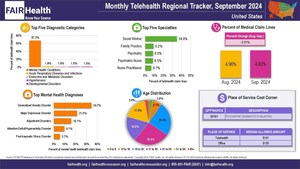Wide Variation across the Nation in Treatment for Opioid Abuse and Dependence
Treatments with the Highest Total Cost Also Vary, according to New FAIR Health Study
NEW YORK, Aug. 14, 2018 /PRNewswire/ -- Whether treatment for opioid abuse and dependence most commonly emphasized methadone administration, naltrexone injection, group psychotherapy or another procedure in 2017 depended on the state or region where the patient received care, according to a new white paper and state-by-state infographics from FAIR Health, a national, independent, nonprofit organization dedicated to bringing transparency to healthcare costs and health insurance information. Which procedures made up the largest share of total expenditures for opioid abuse and dependence also varied by region and state.
Analyzing 2017 data from its database of more than 26 billion privately billed healthcare claim records dating back to 2002, FAIR Health identified the top 10 procedure codes for specific treatments and services associated with opioid abuse and dependence diagnoses by utilization and aggregate cost in each US census region (Northeast, Midwest, South, West) and also reported the top 5 codes by utilization and aggregate cost in each state and the District of Columbia. Procedures include therapeutic procedures and other services, such as drug tests and visits to doctor's offices or emergency departments (EDs).
Among the regional differences the study revealed:
- Methadone administration (H0020) was one of the 10 most common procedures by utilization in every region, but it was among the top 10 by cost in only one region, the Northeast.
- Naltrexone injection (J2315) was in the top 10 list by cost in only one region, the Midwest.
- Group psychotherapy (CPT®1 90853) was one of the 10 most common procedures by utilization in every region except the South.
- The top 10 procedures by utilization in the South included 7 drug tests or test-related procedures, more than in any other region.
- The top 10 procedures by cost in the West included 6 therapeutic procedures, more than in any other region.
- Two outpatient rehabilitative services were found in the top 10 lists by utilization or cost only in the South and West: intensive outpatient treatment (H0015) and partial hospitalization (S0201).
- Two inpatient treatments, sub-acute detoxification (H0010) and short-term residential (H0018), were included among the top 10 procedures by cost in one region, the West.
- ED visits were found in the top 10 lists by cost only in the Northeast and Midwest.
Across states, the study found these differences, among others:
- Only New York had group counseling (H0005) as one of its five most common procedures by utilization and cost.
- Only five states—Delaware, Nebraska, North Dakota, South Dakota and Wisconsin—included psychotherapy, 45 minutes (CPT 90834), as one of their five most common procedures by utilization.
- Only California had intensive outpatient treatment in its top five list by utilization.
- Sub-acute detoxification appeared in the top five lists of only two states, Mississippi and Tennessee, and there only by cost.
- Only Wyoming included among its top five procedures by cost an ED visit, high severity, immediate significant threat to life or physiologic function (CPT 99285).
Dr. Martin A. Makary, Johns Hopkins Professor of Health Policy, said: "FAIR Health has issued an excellent study of an important aspect of the opioid crisis. Treatment of opioid abuse and dependence should be driven by science. This report represents a step in that direction."
FAIR Health President Robin Gelburd commented: "Our study unveils a tapestry of variation by region and state in the procedures most commonly associated with opioid abuse and dependence. The findings transform the states into living laboratories, offering opportunities to research the outcomes linked to the different treatment strategies."
This is the fourth in a series of white papers released by FAIR Health on the opioid epidemic. The first white paper examined national trends in the epidemic; the second, the impact of the epidemic on the healthcare system; and the third, geographic variations in the epidemic.
For the new white paper, click here. For the state-by-state infographics, click here.
Follow us on Twitter @FAIRHealth
About FAIR Health
FAIR Health is a national, independent, nonprofit organization dedicated to bringing transparency to healthcare costs and health insurance information through data products, consumer resources and health systems research support. FAIR Health possesses the nation's largest collection of private healthcare claims data, which includes over 26 billion claim records contributed by payors and administrators who insure or process claims for private insurance plans covering more than 150 million individuals. FAIR Health licenses its privately billed data and data products—including benchmark modules, data visualizations, custom analytics, episodes of care analytics and market indices—to commercial insurers and self-insurers, employers, providers, hospitals and healthcare systems, government agencies, researchers and others. FAIR Health also holds separate data representing the experience of all individuals enrolled in traditional Medicare from 2013 to the present (as well as Medicare Advantage enrollees represented in its private claims data). Certified by the Centers for Medicare & Medicaid Services (CMS) as a Qualified Entity, FAIR Health receives all of Medicare Parts A, B and D claims data for use in nationwide transparency efforts. FAIR Health can produce insightful analytic reports and data products based on combined Medicare and commercial claims data for government, providers, payors and other authorized users. FAIR Health has earned HITRUST CSF and Service Organization Controls (SOC 2) certifications by meeting the rigorous data security requirements of these standards. As a testament to the reliability and objectivity of FAIR Health data, the data have been incorporated in statutes and regulations around the country and designated as the official, neutral data source for a variety of state health programs, including workers' compensation and personal injury protection (PIP) programs. FAIR Health data serve as an official reference point in support of certain state balance billing laws that protect consumers against bills for surprise out-of-network and emergency services. FAIR Health also uses its database to power a free consumer website available in English and Spanish and an English/Spanish mobile app, which enable consumers to estimate and plan their healthcare expenditures and offer a rich educational platform on health insurance. The website has been honored by the White House Summit on Smart Disclosure, the Agency for Healthcare Research and Quality (AHRQ), URAC, the eHealthcare Leadership Awards, appPicker, Employee Benefit News and Kiplinger's Personal Finance. FAIR Health also is named a top resource for patients in Elisabeth Rosenthal's book, An American Sickness: How Healthcare Became Big Business and How You Can Take It Back. For more information on FAIR Health, visit fairhealth.org.
Contact:
Dean Sicoli
Executive Director of Communications and Public Relations
FAIR Health
646-664-1645
[email protected]
1 CPT © 2017 American Medical Association (AMA). All rights reserved.
SOURCE FAIR Health
Related Links
WANT YOUR COMPANY'S NEWS FEATURED ON PRNEWSWIRE.COM?
Newsrooms &
Influencers
Digital Media
Outlets
Journalists
Opted In






Share this article